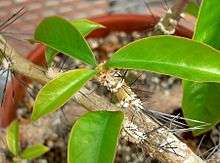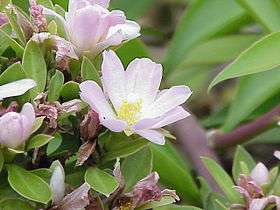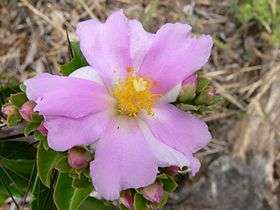Pereskia grandifolia
| Pereskia grandifolia | |
|---|---|
 | |
| Scientific classification | |
| Kingdom: | Plantae |
| Clade: | Angiosperms |
| Clade: | Eudicots |
| Order: | Caryophyllales |
| Family: | Cactaceae |
| Genus: | Pereskia |
| Species: | P. grandifolia |
| Binomial name | |
| Pereskia grandifolia | |
Pereskia grandifolia (rose cactus; syn. Cactus grandifolius Link, Rhodocactus grandifolius (Haw.) F.M.Knuth, Cactus rosa Vell.) is a cactus native to the Northeastern Brazil restingas.
This plant is often used as a medicinal plant and an ornamental plant. In addition, it has edible leaves.
Description
Although Pereskia grandifolia is a cactus by classification, it takes the form of a shrub or small tree, 2–5 metres (6.6–16.4 ft) in height. It has a grayish-brown trunk up to 20 cm in diameter. The areoles are rounded cushion-shaped grayish or brownish tomentum; on the twigs they are 3–7 mm diameter and up to 12 mm on the main trunk. The spines range from black to brown, the number at each areole gradually increasing with age; new twigs can have spineless areoles, while the trunk areoles may have up to 90 spines, each 2-6.5 cm long.
The leaves vary in size from 9–23 cm long, entire, with shapes ranging from elliptic to ovate and obovate-lanceolate.
The dense inflorescence develops at the ends of stems, usually with 10-15 flowers, but sometimes with 30 or more. The flowers are showy and rose-like, 3–5 cm in diameter.


Varieties
- Pereskia grandifolia var. grandifolia is distinguished by having green bracts and a pink flower; it is native to eastern Brazil but widely cultivated in the tropical Americas.
- Pereskia grandifolia var. violacea has purplish-pink or purple bracts and flowers. It was discovered sometime before 1972, initially described as Pereskia bahiensis, but is only distinguished from var. grandifolia by colour. It is apparently native to Espirito Santo and Minas Gerais, but planted by locals in neighbouring states.
References
- Edward F. Anderson, The Cactus Family (Timber Press, 2001), pp. 568–569
- Beat Leuenberger, Pereskia (Cactaceae), Memoirs of the New York Botanical Garden 14 (1986) pp. 111–118
External links
- (in Portuguese) University of São Paulo: Pereskia grandifolia photos
| Wikimedia Commons has media related to Pereskia grandifolia. |